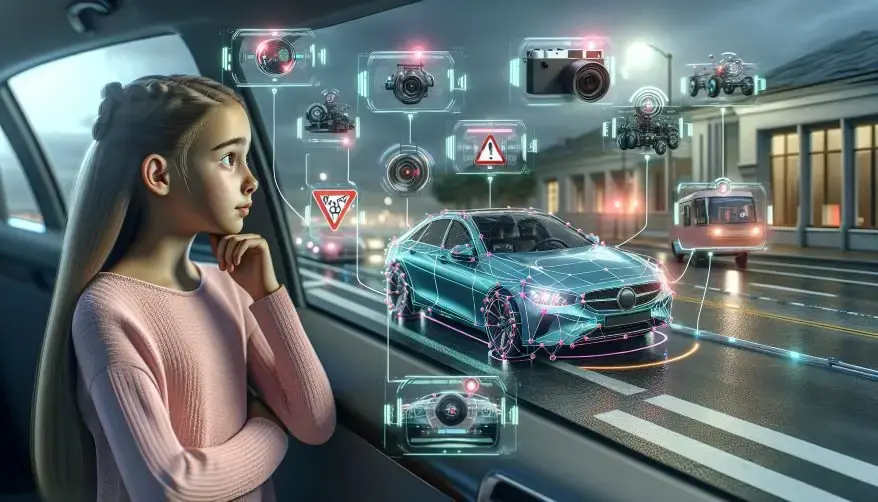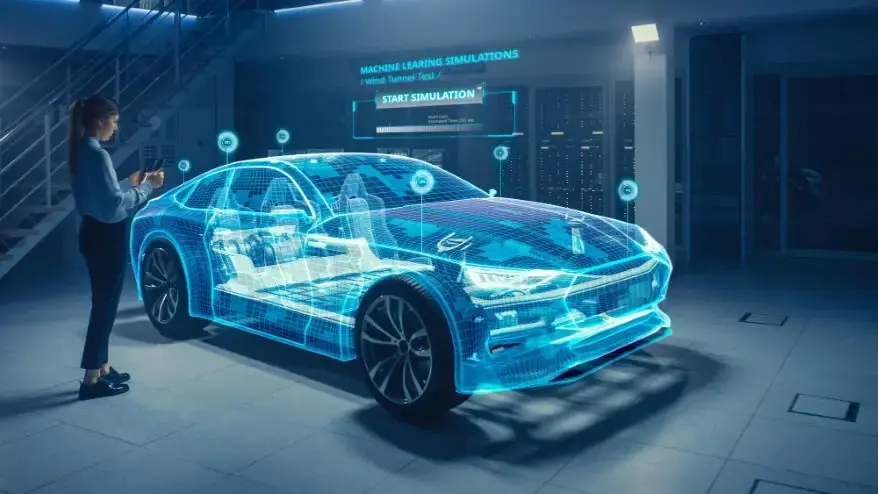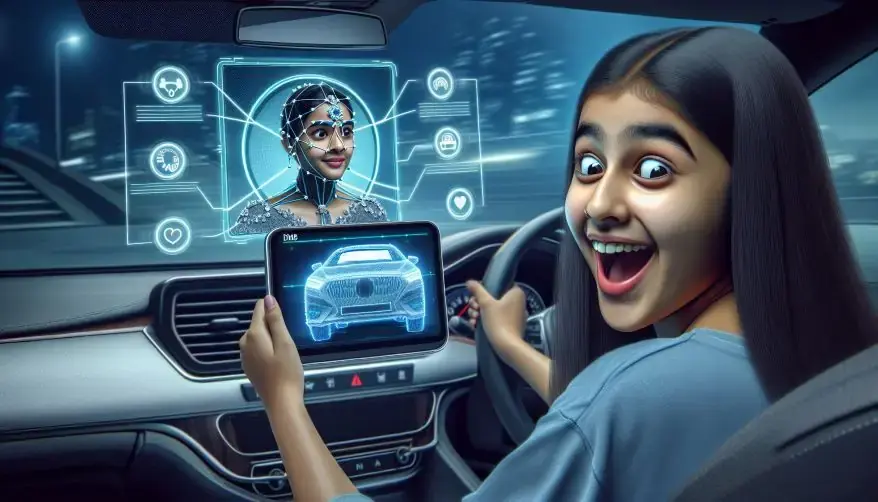AI in Automobile: Transforming the Driving Experience
Artificial intelligence is reshaping how you experience vehicles. In the automotive industry, AI enhances safety, autonomy, and manufacturing efficiency. For instance, AI in automobile works for advanced driver-assistance systems (ADAS) to reduce accidents by predicting and responding to road hazards. Indeed, these innovations could save thousands of lives annually.
Also, the global market for AI in automobile is expected to increase three times by 2030. Particularly, this growth reflects the increasing adoption of technologies like machine learning and computer vision. AI also optimizes manufacturing by improving quality control and streamlining supply chains.

As Henry Ford once said, “Coming together is a beginning; keeping together is progress; working together is success.” AI exemplifies this progress in the automotive world.
AI in Vehicle Safety
Advanced Driver Assistance Systems (ADAS)
Advanced driver-assistance systems are revolutionizing how you drive by making vehicles smarter and safer. Actually, these systems include features like adaptive cruise control, lane-keeping assist, and automatic emergency braking. Basically, adaptive cruise control adjusts your car’s speed to maintain a safe distance from the vehicle ahead. Lane-keeping assist ensures your car stays centered in its lane, while automatic emergency braking applies brakes when a collision seems imminent.

Modern ADAS relies on real-time data processing to enhance safety. Correspondingly, sensors and cameras continuously monitor the environment, enabling your car to respond instantly to potential hazards. For example, traffic sign recognition adjusts your vehicle’s behavior based on road signs, while autonomous emergency steering helps avoid collisions when braking alone isn’t enough. Here’s a quick overview of key advancements in ADAS:
Table 1: Key Advancements in ADAS
| Advancement | Description |
|---|---|
| Lane Departure Warning Systems | Warns if your car drifts out of its lane, evolving into lane-keeping assist. |
| Automatic Emergency Braking | Detects collisions and applies brakes automatically. |
| Adaptive Cruise Control | Maintains a safe following distance and resumes driving in traffic. |
| Blind-Spot Detection | Alerts you to vehicles in blind spots, improving urban safety. |
These features make driving more comfortable and significantly reduce accident risks.
Collision Avoidance
AI in cars plays a critical role in collision avoidance. Undoubtedly, systems powered by AI use sensors, cameras, and radar to monitor your surroundings. These technologies detect obstacles like vehicles, pedestrians, or road debris and alert you in real time. For instance, Mobileye’s EyeQ® chip mimics human understanding of the road to identify hazards and provide timely warnings.

Many modern vehicles come equipped with collision avoidance systems. Examples include automatic braking to prevent impacts and driver alerts for potential dangers. These systems not only protect you but also enhance overall road safety.
Predictive Maintenance
Predictive maintenance ensures your vehicle stays in top condition. AI monitors your car’s health by tracking metrics like engine performance and fluid levels. This approach predicts failures before they happen, saving you from unexpected breakdowns. For example, IoT sensors can detect early signs of brake wear or engine overheating, prompting timely repairs.
This proactive method reduces downtime and repair costs. Studies show predictive maintenance can cut maintenance expenses by up to 20% and unplanned downtime by 50%. It also extends your vehicle’s lifespan, improves safety, and enhances your driving experience. By addressing issues early, you avoid costly repairs and keep your car running smoothly.
Driver Monitoring Systems
AI detection of driver drowsiness and distraction
Driver monitoring systems (DMS) use AI-powered technologies to ensure you stay alert and focused while driving. These systems monitor your behavior and detect signs of drowsiness or distraction in real time. By analyzing your actions, they can identify potential risks and help prevent accidents.

AI in DMS relies on advanced tools to track your physical and emotional state. Some of the key technologies include:
The Cipia-FS10 system, which detects fatigue and distraction. It also identifies actions like smoking, holding a phone, or not wearing a seatbelt.
An optional road-facing camera for enhanced monitoring of your surroundings.
Additionally, these systems use the following methods to ensure your safety:
Facial recognition and gaze tracking: Monitors your eye movement and head position to detect signs of drowsiness.
Emotional state recognition: Analyzes your facial expressions to assess stress or fatigue levels.
Hands-on-wheel detection: Ensures you maintain control by monitoring your hand placement on the steering wheel.
These technologies work together to keep you engaged and reduce the risk of accidents caused by inattentive driving.
Enhancing safety through real-time alerts
Driver monitoring systems enhance safety by providing real-time alerts when they detect risky behavior. For example, if you appear drowsy, the system may sound an alarm or vibrate your seat to grab your attention. These immediate responses can prevent dangerous situations and save lives.

The impact of these systems on road safety is significant. Specifically, driver telematics products have reduced risky driving styles. Over six years, the implementation of DMS led to significant decrease in annual blameworthy accidents. Undoubtedly this highlights how AI-driven monitoring can make roads safer for everyone.
Also Elon Musk once said, “The future of cars is about intelligence and safety.”
Driver monitoring systems embody this vision by combining cutting-edge AI with practical safety measures.
AI in Autonomous Driving
Levels of Autonomy
Overview of the five levels of vehicle autonomy
Autonomous vehicles are classified into five levels based on their automation capabilities. These levels define how much control the vehicle has versus the driver:
Level 0 (No Driving Automation): You control the vehicle entirely without any automation.
Level 1 (Driver Assistance): The vehicle assists with one task, such as adaptive cruise control.
Level 2 (Partial Driving Automation): The car can manage steering and acceleration, but you must stay in control.
Level 3 (Conditional Driving Automation): The vehicle makes decisions, but you need to oversee its actions.
Level 4 (High Driving Automation): The car operates autonomously in most scenarios, though you can intervene if needed.
These levels highlight the gradual shift from manual driving to fully autonomous systems.
Current advancements in autonomous driving technology
Recent advancements in autonomous vehicles have made them smarter and more efficient. Additionally, in 2024, technologies like LiDAR and radar improved environmental perception. Enhanced AI algorithms now allow vehicles to make better decisions. Moreover, the introduction of 5G connectivity enables real-time data sharing, improving coordination between vehicles. Additionally, advancements in battery technology have increased the range and efficiency of autonomous vehicles, making them suitable for long-distance travel.
AI-Powered Sensors and Decision-Making
Role of LiDAR, radar, and cameras in self-driving cars
AI-powered sensors play a critical role in self-driving cars. LiDAR creates detailed 3D maps and measures distances, helping the vehicle detect and avoid obstacles. Radar works effectively in poor weather conditions, ensuring object detection even when visibility is low. Additionally, cameras capture visual data, which AI processes to recognize traffic signs, pedestrians, and other vehicles. Thus, combining these sensors through sensor fusion enhances the car’s ability to perceive and navigate its surroundings.
Real-time decision-making enabled by AI
AI enables self-driving cars to make decisions in real time. It processes data from sensors to predict and respond to environmental changes. However, challenges remain. Particularly, communication delays and sensor limitations can affect decision-making accuracy. Specifically, replicating human behavior adds complexity. As one expert noted, “Unforeseen errors in perception systems can lead to dangerous situations.” For example, a software glitch in California caused a self-driving car to malfunction, highlighting the need for robust systems.
Real-World Examples of Self-Driving Cars
Companies like Tesla, Waymo, and their innovations
Several companies have made significant strides in autonomous vehicles. Waymo, a pioneer in self-driving technology, launched a fully driverless taxi service in Phoenix in 2020 and expanded to San Francisco in 2023. Specifically, Tesla’s Full Self-Driving (FSD) technology has gained public attention for its advanced capabilities. Thus, these innovations showcase the potential of autonomous vehicles to transform transportation.
Success stories and challenges in autonomous driving
Waymo’s driverless taxis have successfully operated in multiple cities, proving the feasibility of autonomous vehicles. However, challenges persist. In 2023, incidents like a Cruise vehicle dragging a pedestrian raised safety concerns. Regulatory issues and public opposition also complicate deployment. For instance, the California DMV revoked Cruise’s license in 2023, citing safety risks. Unquestionably, these challenges highlight the need for continuous improvement and regulation in autonomous driving.
FAQ
What is the role of AI in improving vehicle safety?
AI enhances vehicle safety by enabling features like collision avoidance, driver monitoring systems, and predictive maintenance. Basically, these technologies analyze real-time data to detect hazards, alert you to risks, and prevent accidents. Also, AI ensures safer driving conditions for you and other road users.
How does AI contribute to autonomous driving?
AI powers self-driving cars by processing data from sensors like LiDAR, radar, and cameras. It enables real-time decision-making, allowing vehicles to navigate roads, avoid obstacles, and follow traffic rules. Specifically, companies like Tesla and Waymo use AI to advance autonomous driving technology.
“The only way to discover the limits of the possible is to go beyond them into the impossible.” – Arthur C. Clarke
Conclusion
Artificial Intelligence (AI) is not only revolutionizing the automobile industry but also enhancing safety, efficiency, and user experience significantly. For instance, advanced driver-assistance systems (ADAS) utilize AI to provide crucial features like lane-keeping assist and adaptive cruise control, which in turn reduce accidents and improve road safety. Furthermore, self-driving technology leverages AI algorithms to navigate and make real-time decisions, thereby paving the way for autonomous vehicles. Additionally, AI-powered systems optimize vehicle maintenance and operations, actively predicting issues before they arise. In conclusion, AI is fundamentally transforming how we drive, making vehicles smarter and more connected than ever before.
References
Yang, E., and Yi, O. (2024). Enhancing road safety: Deep learning-based intelligent driver drowsiness detection for advanced driver-assistance systems. Electronics, 13(4), 708. https://doi.org/10.3390/electronics13040708
Shahakar, Y. (2024). Battery charging topology for EV applications. Advancing Innovation in Smart Systems, Energy, Materials, and Manufacturing: Unleashing the Potential of IoT, AI, and Edge Intelligence, 259-270. https://doi.org/10.58532/nbennuraich14
Harrington, S., and Takbhate, S. R. (2025). A comparative analysis of lane keeping assist and lane departure warning systems on curved and straight roadways. Volume 11: Safety Engineering, Risk and Reliability Analysis; Research Posters. https://doi.org/10.1115/imece2024-142179
Young, G. (2024). Using the classic trolley problem to teach AI students and researchers about their role as moral agents, and why they should be subject to moral scrutiny. AI and Ethics. https://doi.org/10.1007/s43681-024-00509-3
Millar, J. (2017). Ethics settings for autonomous vehicles. Oxford Scholarship Online. https://doi.org/10.1093/oso/9780190652951.003.0002






